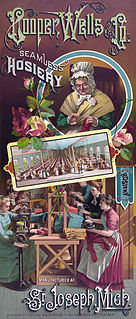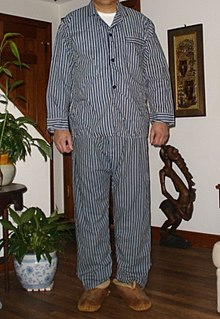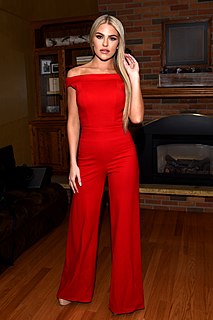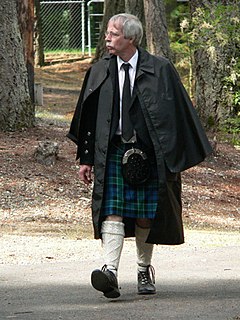
Hosiery, also referred to as legwear, describes garments worn directly on the feet and legs. The term originated as the collective term for products of which a maker or seller is termed a hosier; and those products are also known generically as hose. The term is also used for all types of knitted fabric, and its thickness and weight is defined by denier or opacity. Lower denier measurements of 5 to 15 describe a hose which may be sheer in appearance, whereas styles of 40 and above are dense, with little to no light able to come through on 100 denier items.

A tallit is a fringed garment, traditionally worn as a prayer shawl by religious Jews. The tallit has special twined and knotted fringes known as tzitzit attached to its four corners. The cloth part is known as the "beged" and is usually made from wool or cotton, although silk is sometimes used for a tallit gadol.

A temple garment, also referred to as garments, the garment of the holy priesthood, or Mormon underwear, is a type of underwear worn by adherents of the Latter Day Saint movement after they have taken part in the endowment ceremony. Garments are worn both day and night and are required for any adult who previously participated in the endowment ceremony to enter a temple. The undergarments are viewed as a symbolic reminder of the covenants made in temple ceremonies and are seen as a symbolic and/or literal source of protection from the evils of the world.

Overalls, also called bib-and-brace overalls, or dungarees are a type of garment usually used as protective clothing when working. The garments are commonly referred to as a "pair of overalls" by analogy with "pair of trousers".

A tailor is a person who makes, repairs, or alters clothing professionally, especially suits and men's clothing.

Nightwear – also called sleepwear, nightclothes, or loungewear– is clothing designed to be worn while sleeping. The style of nightwear worn may vary with the seasons, with warmer styles being worn in colder conditions and vice versa. Some styles or materials are selected to be visually appealing or erotic in addition to their functional purposes.

A jumpsuit is a one-piece garment with sleeves and legs and typically without integral coverings for feet, hands or head. The original jump suit is the functional one-piece garment used by parachuters.

A tunic is a garment for the body, usually simple in style, reaching from the shoulders to a length somewhere between the hips and the knees. The name derives from the Latin tunica, the basic garment worn by both men and women in Ancient Rome, which in turn was based on earlier Greek garments that covered wearers' waists.

Dyeing is the application of dyes or pigments on textile materials such as fibers, yarns, and fabrics with the goal of achieving color with desired color fastness. Dyeing is normally done in a special solution containing dyes and particular chemical material. Dye molecules are fixed to the fiber by absorption, diffusion, or bonding with temperature and time being key controlling factors. The bond between dye molecule and fiber may be strong or weak, depending on the dye used. Dyeing and printing are different applications; in printing, color is applied to a localized area with desired patterns. In dyeing, it is applied to the entire textile.

The Garment District, also known as the Garment Center, the Fashion District, or the Fashion Center, is a neighborhood located in the borough of Manhattan in New York City. The dense concentration of fashion-related uses give the neighborhood its name. The neighborhood, less than 1 square mile (2.6 km2), is generally considered to lie between Fifth Avenue and Ninth Avenue, from 34th to 42nd Streets.

A hazmat suit, also known as decontamination suit, is a piece of personal protective equipment that consists of an impermeable whole-body garment worn as protection against hazardous materials. Such suits are often combined with self-contained breathing apparatus (SCBA) to ensure a supply of breathable air. Hazmat suits are used by firefighters, emergency medical technicians, paramedics, researchers, personnel responding to toxic spills, specialists cleaning up contaminated facilities, and workers in toxic environments.
Clothing terminology comprises the names of individual garments and classes of garments, as well as the specialized vocabularies of the trades that have designed, manufactured, marketed and sold clothing over hundreds of years.

A dressmaker is a person who makes custom clothing for women, such as dresses, blouses, and evening gowns. A dressmaker is also called a mantua-maker (historically) or a modiste.
A teddy, also called a camiknicker, is a garment which covers the torso and crotch in the one garment. It is a similar style of garment to a one-piece swimsuit or bodysuit, but is typically looser and more sheer. The garment is put on by stepping into the leg holes and pulling the garment up to cover the torso. It may cover the whole of the torso or partially and may also cover the arms. They may open at the crotch for use with a commode, without the need to remove all clothing. As an undergarment, it combines the functions of a camisole and panties, and may be preferred to avoid a visible panty line. It is also found as lingerie.

Clothing fetishism or garment fetishism is a sexual fetish that revolves around a fixation upon a particular article or type of clothing, a particular fashion or uniform, or a person dressed in such a style.

Fashion design is the art of applying design, aesthetics and natural beauty to clothing and its accessories. It is influenced by cultural and social attitudes, and has varied over time and place. Fashion designers work in a number of ways in designing clothing and accessories such as bracelets and necklaces. Because of the time required to bring a garment onto the market, designers must at times anticipate changes to consumer tastes.
Made-to-measure (MTM) typically refers to custom clothing that is cut and sewn using a standard-sized base pattern. Suits and sport coats are the most common garments made-to-measure. The fit of a made-to-measure garment is expected to be superior to that of a ready-to-wear garment because made-to-measure garments are constructed to fit each customer individually based on a few body measurements to customize the pre-existing pattern. Made-to-measure garments always involve some form of standardization in the pattern and manufacturing, whereas bespoke tailoring is entirely made from scratch based on a customer's specifications with far more attention to minute fit details and using multiple fittings during the construction process. All else being equal, a made-to-measure garment will be more expensive than a ready-to-wear garment but cheaper than a bespoke one. "Custom made" most often refers to MTM. Country of origin makes a difference in pricing, with made in China MTM garments typically priced below made in Italy ready-to-wear.

The textile and clothing industries provide the single source of growth in Bangladesh's rapidly developing economy. Exports of textiles and garments are the principal source of foreign exchange earnings. By 2002 exports of textiles, clothing, and ready-made garments (RMG) accounted for 77% of Bangladesh's total merchandise exports. In 1972, the World Bank approximated the gross domestic product (GDP) of Bangladesh at US$6.29 billion, and it grew to $173.82 billion by 2014, with $31.2 billion of that generated by exports, 82% of which was ready-made garments. As of 2016 Bangladesh held the 2nd place in producing garments just after China. Bangladesh is the world's second-largest apparel exporter of western fast fashion brands. Sixty percent of the export contracts of western brands are with European buyers and about forty percent with American buyers. Only 5% of textile factories are owned by foreign investors, with most of the production being controlled by local investors. In the financial year 2016-2017 the RMG industry generated US$28.14 billion, which was 80.7% of the total export earnings in exports and 12.36% of the GDP; the industry was also taking on green manufacturing practices.

A cape is a sleeveless outer garment, which drapes the wearer's back, arms, and chest, and connects at the neck.

A thawb or thobe, also called a Qamīṣ Somali: khamis, is an ankle-length garment, usually with long sleeves, similar to a robe, kaftan or tunic. It is commonly worn in the Arabian Peninsula, Iraq, neighbouring Arab countries, the southern ports and Islands of Iran, and some countries in East and West Africa. A sirwal or pants, izaar or lungi are typically worn underneath.
















